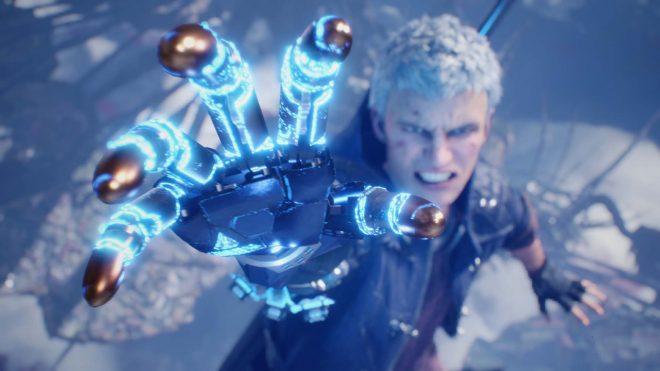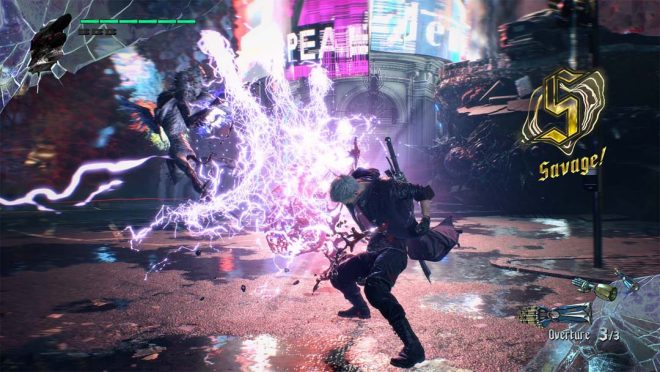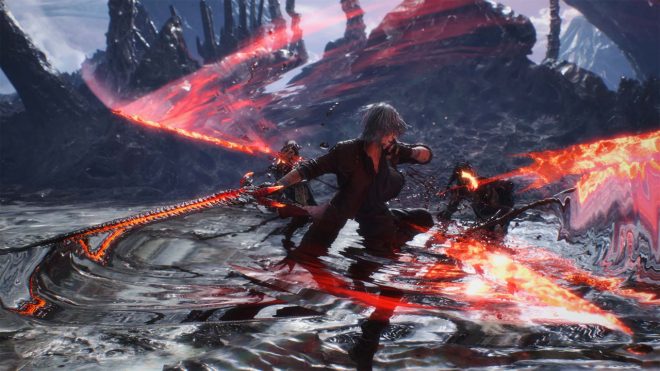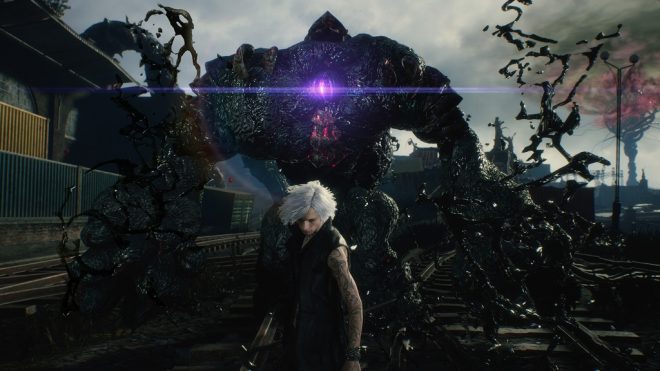Devil May Cry V — Men of Arms

It’s been a few years since Capcom claimed they were essentially going back to what worked for them, with the plan to develop all their games within their internal Japanese studios and expand them instead of giving projects to seemingly random western developers. The extremely popular Monster Hunter: World, Resident Evil 7, and the superlative Resident Evil 2 remake were created as a result, all of which turned out well. The newest game to come from this is Devil May Cry V.
In fact, returning to what worked about the DMC franchise and the desires of the very vocal fanbase makes this game a rarity in the gaming world. The franchise was rebooted with the Ninja Theory-developed DmC: Devil May Cry, and while that game turned out much better than skeptics expected (me included), it wasn’t the installment fans wanted, which showed in the sales numbers (see #24, and how it’s below the last mainline title). This explains why Capcom went back to the main DMC series for a sequel, something unusual for a video game franchise after a reboot. Fortunately, Capcom’s aforementioned strategy mostly worked out for this game — mostly.

DMCV takes place in an unspecified amount of time after Devil May Cry 4, and involves several returning characters from previous mainline installments involved in more demon fighting. It takes place in Red Grave City, a formerly bustling location in an unspecified part of the world ravaged by emerging demonic forces. This is thanks to the rise of a big-time demon named Urizen, who’s planted a vampiric tree to suck the blood from the city’s inhabitants known as the Qliphoth. The game starts with series mainstay Dante and his partners, Lady and Trish, failing to stop it, while returning DMC4 protagonist Nero and new character V retreat to rearm themselves and try again — literally, in the former’s case.
The story lives up to the franchise standard — it’s gloriously cheesy fun in parts, but unremarkable overall. It’s a paper-thin excuse to bring back fan favorite characters and creatures from previous games. It’s also a shame those fan desires didn’t extend to the returning female characters making an impact. Lady once again does nothing worthwhile despite being a capable fighter as a young woman in Devil May Cry 3, and Trish joins her in being nearly useless.
The biggest attraction for DMC games is the combat, specifically the combo potential and enemy encounters. Capcom realized what worked with the previous DMC games and reapplied the philosophy. It features Nero, V, and Dante as playable characters who have their own move sets and arsenal, and each one has enemy encounters tailored to their playstyles. In other words: It skillfully avoids one of the key pitfalls in DMC4, where nearly all the enemies and bosses were made for Nero to fight. They weren’t balanced for Dante, who could easily overpower all of them. The good balance prevents this game from being as much of a slog.

Nero is the easiest character to play, which is why he’s the first one players control. I had a tough time readjusting to him after playing the demo, since many techniques unlocked for him there were locked initially here, and required a bunch of Red Orbs to unlock here. He’s still a lot of fun to use, and his combo potential is increased thanks to the new Devil Breakers. These are special arms that take the place of the ripped-off Devil Bringer made for him by new character Nico, which have a variety of functions. They include producing a powerful hand that damages enemies in the area, producing a wire that can hit and combo surrounding enemies, and even a rocket-propelled hand.
He has more combat options compared to his DMC4 self, but there’s still potential for more. He’s still limited to one main melee weapon (the Red Queen sword) and one six-shooter gun for basic attacks and combos. It also doesn’t make sense that he can’t switch between Devil Breakers, and instead has to break them or have them broken to shift to the next one. His full potential also doesn’t unlock until the end of the game — the very last mission, in fact. Several good combos can’t be used against regular enemies unless you venture into the Bloody Palace mode (a mode gauntlet, essentially) or replay the game.
V is the most interesting playable character in the game, in how he goes against the DMC franchise’s gameplay principles. He can barely attack enemies directly, and relies on demons he summons to fight for him, the latter of which are returning enemies from the first Devil May Cry game. V is the only one who can finish enemies in combat, however. He’s fun to use, but I found myself getting frustrated whenever the summoned demons sometimes hesitated to hit enemies within full view. I also wish he had something more to defend himself with, as he has to run around helpless when his summoned demons are temporarily KO’d if they take too much damage. He’s fun, but not as fun as the other characters.

Dante is still the hardest to play, thanks to having access to four different melee weapons, four long-range weapons, and four Styles with different offensive and defensive maneuvers attached to all of them that can be switched at any time. He’s toned down compared to his DMC4 counterpart in terms of power, but still has a ridiculous amount of potential. It’s good that the game gives players a better chance to use his arsenal this time around, and playing him is nostalgic not only because he’s the most well-known character in the franchise, but because his weapons and move set are a “best of” for the series.
There’s a reason why I focused on the combat above, since it’s the overwhelming focus and by far the best part of DMCV. The level design is good early in the game, but falls of a cliff later on — notably in a different way compared to DMC4. Earlier levels take place in a ruined metropolis, with good variety between the environments. The later levels, however, occur within the same location, and have little variety aesthetically. Worse, they consist of little more than rooms full of enemy encounters that characters travel between, which almost makes them feel like the aforementioned Bloody Palace mode with a story. It doesn’t feel as monotonous as DMC4’s second half, which had Dante backtrack through almost every level Nero cleared with new gimmicks. But it’s not as good as it could have been.

DMCV never stops being a looker in terms of graphical prowess, which is not only the first installment to be made on Capcom’s new RE Engine internal development tools, but the first non-Resident Evil game made with it. In the process, Capcom swapped out the previous DMC games’ fusion of anime and realism for its art style to focus completely on the latter, and the results are great. The sound design and music accompany this, including the battle themes for the main three characters and the calmer instrumental themes outside of battle. I have no complaints about the presentation.
I was down on a few parts of DMCV, but the overall product is still worth playing — especially for fans. It’s evident the developers were either strained to make it as long as previous installments, or exhausted the budget Capcom gave them; but it fortunately doesn’t overstay its welcome. It’s a shame the team is having a hard time making a game on par with DMC3, or even the first game in terms of level design, for whichever reason. Considering this installment fells like a conclusion of sorts to the overarching story, and how this sold well, I’m eager to see what they have planned for the next installment whenever it arrives.
In the meantime, it would be nice if Capcom broke that DLC promise and added more playable characters — Trish and Lady especially, considering how little they do in the story. But it also wouldn’t surprise me if a Special Edition was coming.





